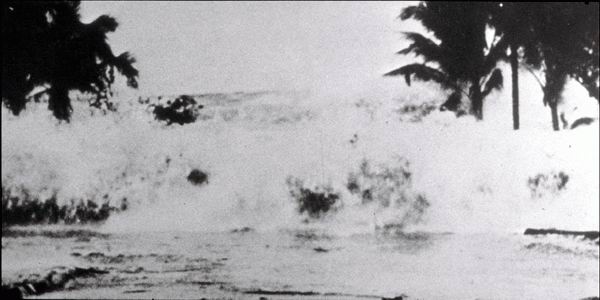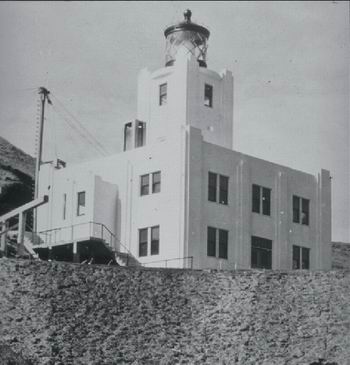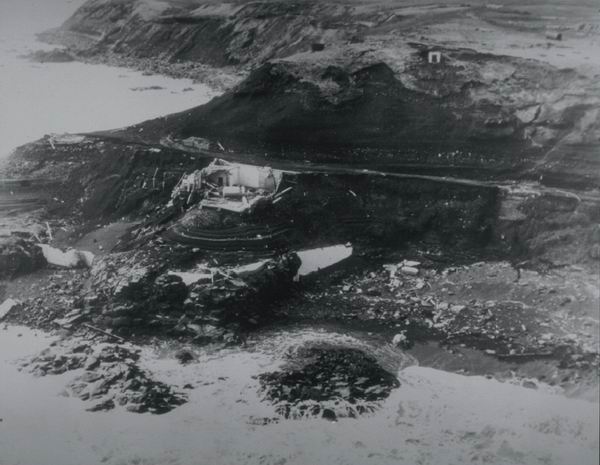My writing specialty when I got started was explaining technical and scientific topics for lay audiences, which served me well when I applied for a “tech transfer” job at NASA’s Jet Propulsion Laboratory. (Tech transfer: publishing — “transferring” — JPL’s basic technical research to industry or the public.)
This was written for a class in journalism school. It’s an early example of my model of “write it once, publish again and again” — once it was written for my professor and a grade, I then tried to sell it to a magazine, but failed.
Then an earthquake triggered a tsunami in Alaska that threatened the entire Pacific basin. I quickly updated the article and marketed it again, this time quickly selling it to Westways magazine for their October 1986 issue. In a stroke of great timing, it came out the day before I interviewed at JPL, and I was able to hand over the magazine and say “Here’s a recent article I wrote.”
The interviewer merely glanced at it, and said, “I read that at home last night. It was very good.” I got the job.
– – –
Tsunamis: More than Big Waves
by Randy Cassingham
Last May’s [1986] magnitude 7.7 earthquake off Adak island in Alaska awakened a sickly fear in many coastal residents’ minds, a sense of curiosity in others, and an indifferent shrug from some. For the first time in years, a public warning echoed around the Pacific: a wall of water was on the way, to arrive in several hours.
Most of us in the United States call them “tidal waves,” but they have nothing to do with the tides. Experts call them tsunamis (pronounced “sue-nah-mes”), a Japanese word meaning “harbor wave.” Pacific coast residents, many of whom live just a few miles from the ocean, are in danger if a tsunami occurs. But few people know how tsunamis are generated or even just what they are.
Almost all tsunamis occur in the Pacific Ocean, an area of high earthquake activity. When a tsunami is generated anywhere in the Pacific, every Pacific coastline is in danger, from Alaska down the west coast, South America, Hawaii and Japan.
Not all underwater earthquakes produce the sea waves. To start a tsunami, an underwater earthquake with vertical motion must measure at least 6.5 on the Richter Scale and must be centered less than 30 miles under the ocean floor. Also, large volcanic explosions and underwater landslides can sometimes generate the waves.
When a tsunami is generated, it races across the ocean at up to 670 miles per hour, the speed being determined solely by the depth of the water. In open water, the wave cannot be seen or felt by boats, and doesn’t even noticeably rise above sea level until it reaches land. Tsunamis cannot capsize ships in open water — no matter what you saw in The Poseidon Adventure. In fact, one of the safer places to be during a tsunami is out in deep water. When a tsunami warning comes, most ships will head out to sea if there is time.
As a tsunami reaches shallower water and approaches land, its speed drops. In 60 feet of water, speed goes down to about 30 mph. But when the speed drops, the water behind the wave builds up and the wave rises in height. By the time it crests at a beach, the wave can be many feet high.
After the tsunami first hits land, the disaster isn’t over. A tsunami is not just one wave but a series of waves, much like dropping a rock into a pool of water. From the point of the original earthquake, rings of waves travel in every direction. Waves then hit distant shores one after another up to two hours apart.

The first wave usually isn’t the largest, though marine scientists are not sure exactly why. And the third and fourth waves sometimes are even bigger than the second. “I’ve seen records where the maximum wave might have occurred 24 hours after the first,” says Mark Spaeth, the Tsunami Program Director of the National Weather Service and one of the nation’s leading experts on tsunamis.
Between each of the waves, coastal waters often recede. They can rush away to a level lower than that of the lowest tides, and may do so even before the first wave hits. Sometimes when the water rushes away, people at the shore will walk onto the newly exposed area, fascinated by the flopping fish that suddenly find themselves out of water. When the people finally see the quickly approaching wave it’s too late. If you see the water suddenly rise or drop, “you should take nature’s warning on your own initiative” and run towards higher ground, says Commander Ken Lilly, the west coast marine officer of the National Oceanic and Atmospheric Administration (NOAA) corps, the federal agency responsible for the study of tsunamis and the issuance of warnings when the waves are generated.


“Tsunamis are not that rare,” says Lilly. Hawaii is hit by an average of 52 tsunamis per century; and the Pacific coast of the continental U.S. suffers about 34, or an average of one every three years. However, while tsunamis themselves are not that rare, Lilly continued, “the ones that are damaging are.” There has not been a major tsunami to hit the west coast since 1964. “You might say we’re overdue” for a destructive tsunami, he said.
Since 1906, several very destructive tsunamis have hit in the United States: three in Hawaii, three in Alaska, and five on the west coast of the lower 48 states. The last destructive tsunami to hit the continental U.S., in 1964, caused major damage in Crescent City, Calif., near the Oregon border. Much of the downtown area was wiped out and 11 people were killed. Those waves were generated by a magnitude 8.5 [later re-evaluated to measure 9.2-9.3] earthquake in the waters off Alaska. Several hours later, 18-foot waves hit Crescent City, causing $7.5 million in damages. Other areas on the west coast were also hit, but received less damage. Marin county, for instance, suffered $1 million in flood damages because of the waves.
Tsunami waves can be giants. The largest tsunami on record hit in 1737 on Cape Lopatka, on the north coast of Asia about 1,300 miles north of Japan. The waves there were about 210 feet high. Despite a common belief that tsunami waves are all giants, most are not. But tsunamis don’t have to be big to cause widespread damage. “People that I’ve talked to often tell me, ‘it wasn’t very big, but it kept coming and coming’,” Spaeth said. In such disasters, flooding can cause more damage and death than the sudden weight of the wave hitting.
Shortly after that tsunami hit, it was realized that if the waves took five hours to reach the island, a warning system could be put into effect to allow time for evacuation. The U.S. government built a seismographic system to determine the location and magnitude of earthquakes in the Pacific, and a network of tide gauges was added to watch for waves.
From their headquarters at the Honolulu Observatory, the Pacific Tsunami Warning System monitors the seismographs and tide gauges that ring the Pacific. The office is manned 24 hours-a-day. The system was first used on November 4, 1952 when a Pacific earthquake generated a tsunami. Six hours later, the waves hit Hawaii. But due to the advanced warning, no lives were lost.
When the system’s monitors detect a major earthquake, its location and magnitude are quickly plotted by computer. If the magnitude is sufficient to generate a tsunami, a “tsunami watch” is issued to all weather stations (which relay the warnings to boaters) and local government offices on the coast. Since wave speed is based on the depth of the ocean and average depths are known, an approximate arrival time of the waves can be calculated by the computer. However, since not all earthquakes generate tsunamis, the actual existence of the waves can only be determined by the tide gauges or coastal observation.
If the existence of tsunami waves are confirmed by the tide gauges or land near the earthquake is hit by a wave, a “tsunami warning” goes into effect. Coastal areas are told when they can expect waves, but the size of the approaching waves cannot be determined. Wave size depends on the intensity of the earthquake, the distance the waves travel, the direction the waves are coming from and, importantly, the underwater geography near the coast. A wave may be barely noticeable in one spot but may be very destructive only a few miles away.
In the United States today, the tsunami warning system is operated by the National Weather Service, a division of NOAA. A few years ago, NOAA sent Ken Lilly and Mark Spaeth to the west coast to confer with local government officials. NOAA wanted to remind coastal authorities of the tsunami threat and suggest that coastal communities have a tsunami disaster plan drawn up before it’s too late.
“Admittedly, these are rare events,” Spaeth told the disaster officials. “They are probably low on your list of priorities.” But, he said, it is important for coastal areas to prepare a response for tsunami emergencies now, not when they are notified that waves are just a few hours away. It is only a matter of time until it happens.
Last May’s Adak tsunami was a warning. The waves it generated turned out not to be large enough to see. If we are lucky, the scare made people more aware of the potential danger. If we weren’t lucky, it made people think that the next tsunami warning can be ignored. And that could be a fatal mistake.
- Not all earthquakes cause tsunamis, but many do. When you hear that a strong earthquake has occurred, stand by for a tsunami emergency.
- An earthquake in your area is a natural tsunami warning. Do not stay in low-lying coastal areas after a local earthquake.
- A tsunami is not a single wave, but a series of waves. Stay out of danger areas until an “all-clear” is issued by authorities. Waves can be an hour apart.
- Approaching tsunami are sometimes heralded by a noticeable rise or fall of coastal waters. This is nature’s tsunami warning and should be heeded.
- A small tsunami at one beach can be a giant a few miles away. Don’t let the modest size of one make you lose respect for all.
- The Tsunami Warning System does not issue false alarms. When an ocean-wide warning is issued, a tsunami exists. When a regional warning is issued, a tsunami probably exists. The tsunami of May 1960 killed 61 people in Hilo, Hawaii, who thought it was “just another false alarm.”
- All tsunamis, like hurricanes, are potentially dangerous, even though they may not damage every coastline they strike.
- Never go down to the beach to watch a tsunami! When you can see the wave you are too close to escape it.
- Sooner or later, tsunamis visit every coastline in the Pacific. Warnings apply to you if you live in any Pacific coastal area.
- During a tsunami emergency, your local Civil Defense, police, and other emergency organizations will try to save your life. Give them your fullest cooperation.
- Potential danger areas are those less than 50 feet above sea level and within one mile of the coast for tsunami of distant origin, or less than 100 feet above sea level and within one mile of the coast for tsunami of local origin.
Other links with background info (all open in new windows):
- Scientific Background on the Indian Ocean Earthquake and Tsunami (from Columbia University’s International Research Institute for Climate Prediction)
- The Pacific Tsunami Museum has interesting information and photographs.
- NOAA’s main tsunami portal, their Pacific Marine Environmental Laboratory’s Tsunami Research Program site and their Tsunami Hazard Mitigation Program.
- The U.S. Federal Emergency Management Agency’s Guide to Citizen Preparedness: Tsunamis.
- The University of Southern California’s Tsunami Research Group.
